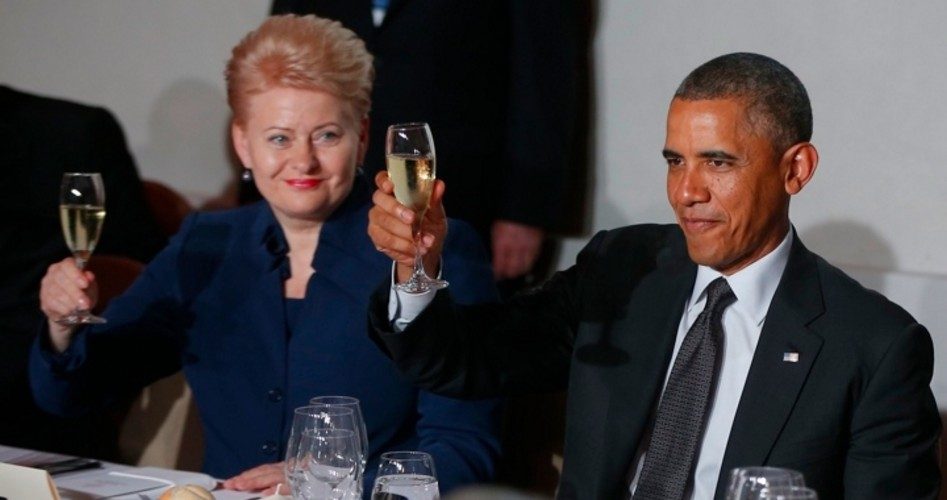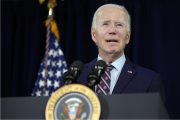
Speaking in Warsaw, Poland, on June 3, President Obama proposed the creation of a European Reassurance Initiative, a $1-billion fund that would be used to increase a U.S.-led military presence in Central and Eastern Europe.
Appearing alongside Polish President Bronislaw Komorowski (shown), Obama said the European Reassurance Initiative demonstrates America’s “unshakable commitment” to its NATO allies. Poland has been a NATO member since 1999.
“I’m starting the visit here because our commitment to Poland’s security as well as the security of our allies in central and eastern Europe is a cornerstone of our own security and it is sacrosanct,” Obama said at Okecie Military Airport, where Komorowski welcomed Obama “against the background of the F-16 aircraft — Polish and American aircraft.”
Obama used the event to comment on the U.S. reaction to the ongoing crisis in Ukraine, which has resulted from Russia’s annexation of Crimea and the Kremlin’s support of pro-Russian separatists in Ukraine:
Given the situation in Ukraine right now, we’ve also increased our American presence. We’ve begun rotating additional ground troops and F-16 aircraft into Poland. And this is going to help our forces train together. This is going to help our forces support NATO air missions. It’s also part of NATO’s stepped-up presence across Central and Eastern Europe. And I look forward to announcing some additional steps later today.
Speaking to the media, Komorowski said:
The decisions of the American authorities to increase its presence in the Eastern countries of NATO are very important. We welcome them with great hope. And we welcome these decisions as an announcement of a true return of NATO to focusing very strongly on questions that are connected at the foundations of the alliance, which is Article 5 of the [NATO] Washington Treaty that refers to the collective defense — the defense on the basis of solidarity of the territories, the homelands of the member states.
Obama also mentioned Article 5 when he said at Belweder Palace, the residence of Poland’s president: “I’ve come here, first and foremost, to reaffirm the enduring commitment of the United States to the security of Poland. As NATO allies, we have an Article 5 duty to our collective defense. As president, I’ve made sure that the United States is upholding that commitment.”
Article 5 of the NATO Charter notes that “an armed attack against any one or more of [the member nations] shall be considered an attack against them all….”
VOA News reported that during his news conference with Komorowski, Obama said that further provocation by Russia in Ukraine will bring costs for Russia, including possible sanctions.
“Basic principles of territorial integrity and sovereignty and freedom, the ability for a people to make their own determinations about their country’s future, is the cornerstone of the peace and security that we have seen in Europe over the last several decades and that is threatened by Russian actions in Crimea and now Russian activity in eastern Ukraine,” said Obama.
During the Belweder Palace conference, Obama announced “a new initiative to bolster the security of our NATO allies here in Europe,” and noted that “under this effort, and with the support of Congress, the United States will pre-position more equipment in Europe.”
Obama also stated that the United States will:
… increase the number of American personnel — Army and Air Force units — continuously rotating through allied countries in Central and Eastern Europe. And we will be stepping up our partnerships with friends like Ukraine, Moldova and Georgia as they provide for their own defense. I’m calling on Congress to approve up to $1 billion to support this effort, which will be a powerful demonstration of America’s unshakable commitment to our NATO allies.
The Los Angeles Times reported that Obama was expected to outline details of the plan at private meetings Tuesday with Komorowski. He also discussed the plan during a separate conference with leaders from other NATO nations in the region, including the Czech Republic, Hungary, Lithuania, Latvia, and Estonia.
A fact sheet for the initiative posted on the White House website on June 3 outlined how the United States plans to spend one billion dollars of taxpayer money:
• Increase exercises, training, and rotational presence across Europe but especially on the territory of our newer allies. Many of the U.S. air and ground forces participating in these activities would rotate from the United States.
• As we have done in Poland, deploy detachments of U.S. planners to augment the capability of our allies to design and host a broad range of training and exercise opportunities.
• Increase the responsiveness of U.S. forces to reinforce NATO by exploring initiatives such as the prepositioning of equipment and improvements to other reception facilities and infrastructure in Europe.
• Increase participation by the U.S. Navy in NATO naval force deployments, including more persistent deployments to the Black and Baltic seas.
• Build the partner capacity of close friends such as Georgia, Moldova, and Ukraine so they can better work alongside the United States and NATO, as well as provide for their own defense.
The key factor underlying the Obama visit to Poland and his announcement of an increased U.S. commitment to NATO partners in Eastern Europe is the little-known understanding of NATO by most Americans.
NATO was originally billed as a defense compact entered into in 1949 by the United States, Canada, Portugal, Italy, Norway, Denmark, Iceland, and the five Treaty of Brussels states — Belgium, the Netherlands, Luxembourg, France, and the United Kingdom. In the aftermath of World War II, with the Soviet Union and its Warsaw Pact allies firmly entrenched in Eastern Europe, the first NATO Secretary General, Lord Ismay, said that NATO’s goal was “to keep the Russians out [of Western Europe], the Americans in, and the Germans down.”
As both presidents Obama and Komorowski readily noted, an important part of what gives NATO its teeth is Article 5. Obama said at Belweder Palace that “As NATO allies, we have an Article 5 duty to our collective defense.”
As The New American’s editor, Gary Benoit, pointed out in his article of April 5, 2009:
Under NATO, the United States is expected to view an attack on any of the 27 [now 28] other member nations — including Soviet-era Warsaw Pact nations that provided the rationale for creating NATO in 1949 — as an attack upon the United States. Article V of the North Atlantic Treaty makes this clear: “The Parties agree that an armed attack against one or more of them in Europe or North America shall be considered an attack against them all.”
We noted above that Georgia is specifically mentioned in the White House’s fact sheet about the European Reassurance Initiative as a non-member nation that “can better work alongside the United States and NATO.” As Benoit noted in his article: “Georgia, for example, is expected to join NATO in the future. If Georgia were already a member of NATO during its war with Russia last year [2008], the United States, along with all other NATO members, would have been expected to come to its aid.”
And most Americans think the Cold War ended in 1991!
Most Americans are also unaware that U.S. membership in NATO (and NATO clones such as SEATO) has already embroiled the United States in wars that have cost us many casualties. John F. McManus, president of The John Birch Society, expanded on this point in an article posted on April 4:
In 1950, membership in NATO was cited by President Truman as his authority to send American forces into Korea to counter North Korea’s invasion of its southern neighbor.
Later, the precedents established by NATO led to creation of a virtually identical treaty known as the Southeast Asia Treaty Organization (SEATO). President Lyndon Johnson pointed to it for authority to commit hundreds of thousands of U.S. forces to Vietnam.
More recently, writes McManus, “U.S. forces that have been in Afghanistan for almost [13] years were originally sent under authorization supplied by the UN’s NATO stepchild. Their continued participation in this dragged-out venture has always been a NATO/UN operation.”
With a national debt of $17.5 trillion, the United States can ill afford to spend $1 billion on a European Reassurance Initiative to increase our military presence in Eastern Europe. We can afford even less the prospect of adding thousands more American lives to those already spent in places such as Korea, Vietnam, Iraq, and Afghanistan.
Photo of Polish President Bronislaw Komorowski and U.S. President Barack Obama in Warsaw: AP Images
Related articles:
Biden Challenges Air Force Academy Grads to Shape a “New World Order”


